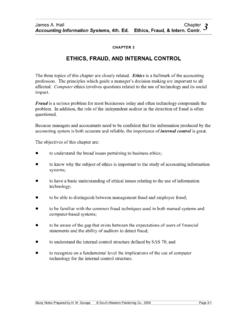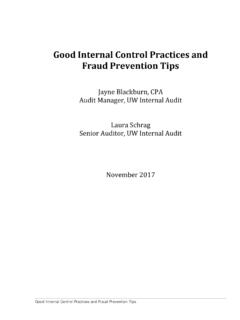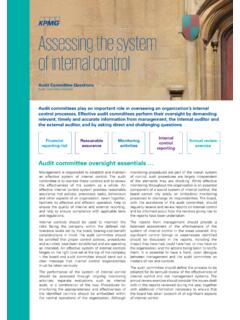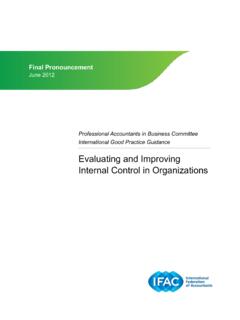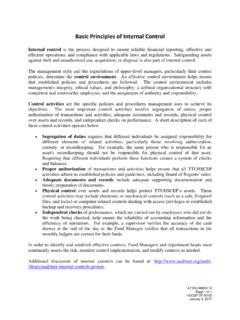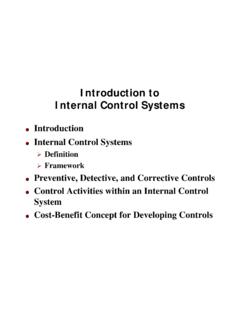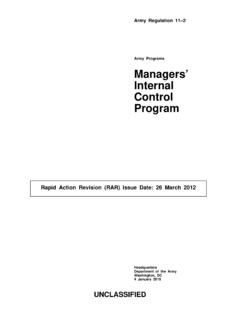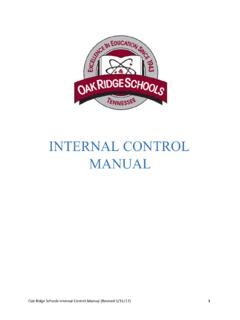Transcription of Internal Control Framework - World Health Organization
1 Internal Control Framework November 2013 2 ANNEX ANNEXES Table of Contents Table of Contents .. 2 1. INTRODUCTION .. 3 2. SCOPE AND DEFINITION OF Internal Control .. 4 3. THE FIVE COMPONENTS AND EIGHTEEN PRINCIPLES OF Internal Control : .. 5 I/ Internal Environment .. 5 II/ Risk Assessment .. 6 III/ Control Activities .. 6 IV/ Information and Communication .. 7 V/ Monitoring .. 7 4. ROLES AND RESPONSIBILITIES FOR Internal Control .. 8 5. Internal GOVERNANCE FOR Internal Control Framework .. 12 6. PROVIDING ASSURANCE ON Internal Control AT WHO .. 13 7.
2 LIMITATION OF Internal Control CONCEPT OF REASONABLE ASSURANCE .. 13 ANNEX A WHO s Principles of Internal Control and their Applicability to Managers .. 14 3 1. Introduction The World Health Organization (WHO or the Organization ) consistently seeks to strengthen the ways in which it achieves expected results, accountability and stewardship of its resources. The Executive Board (EB), at its special session on reform in November 2011, recommended that the Secretariat strengthen its Internal Control Framework by linking it to roles and responsibilities assigned to staff, with routine monitoring of compliance and management action for breaches of compliance.
3 The United Nations Joint Inspection Unit also recommended that the Director-General ensure that the compliance and Control mechanisms at different levels of the Organization be integrated into a coherent and comprehensive Internal Control The purpose of this policy Framework is to strengthen WHO s Internal Control system in response to risks to the Organization s mandate and objectives and to delineate precisely what the Internal Control system consists of within the WHO context. It is designed to guide the development of policies, procedures and systems that could be applied to all levels of the Organization .
4 It will support managers in assessing and enhancing the performance of their Organization /area of responsibility. It includes: the scope and definition of the Internal Control Framework , to ensure that all WHO employees have a common understanding of the concept of Internal Control and how it is applied within the Organization ; the components and the relevant principles (based on acknowledged best practices) required for an effective system of Internal Control and against which the system of Internal Control can be assessed and enhanced; the roles and responsibilities of various players in implementing and operating Internal controls.
5 The governance and oversight structure for the Internal Control Framework ; the manner in which the overall effectiveness of the Internal Control system in WHO is monitored, assessed and reported on; and the limitations inherent to any system of Internal Control . This document will be supplemented by: a Manager s guide to Internal Control , which aims to support managers in implementing and operating Internal Control in their the day-to-day operations; and a checklist which will allow managers and functional area specialists to carry out a high level assessment of Internal controls within their units.
6 The WHO Internal Control Framework , along with the WHO Accountability Framework , are critical systems and structures that ensure the Organization achieves its mandate and objectives. The frameworks are integrated and are supportive of each other, accountability is a key Internal environmental Control element within the Internal Control Framework and Internal controls are critical supporting elements to the accountability Framework . 1 Review of Management, Administration and Decentralization in the World Health Organization (WHO) - Part 1, Review of Management and Administration, Recommendation #13, Joint Inspection Unit, 2012 4 ANNEX ANNEXES 2.
7 Scope and Definition of Internal Control WHO considers Internal control2 as: a process, designed to provide reasonable assurance to WHO management regarding the achievement of objectives relating to operations, reporting and compliance. The definition is broad and reflects that it is more than financial objectives and financial controls. It includes programme operations, human resources, procurement, travel and safeguarding of assets. As illustrated in Figure 1, it is aimed toward the achievement of three objectives: Operations Objectives - related to the effectiveness and efficiency of all operations, Reporting Objectives - related to the financial and non-financial reporting and its reliability, timeliness, transparency or meeting of other requirements that may be established by WHO; and Compliance Objectives - related to the WHO s adherence to applicable policies, rules, and regulations.
8 Figure 1 - Key Objectives of Internal Control An effective Internal Control system helps an Organization to: Promote orderly, economical, efficient and effective operations and use of the Organization s resources. Deliver programmes and services consistent with the Organization s mission. Safeguard resources against loss due to waste, abuse, mismanagement, errors and fraud. Promote adherence to statutes, regulations, policies and procedures, and ethical values. Identify risks and develop effective strategies and procedures to Control or manage them.
9 2 Based on the definition provided by the Committee of Sponsoring Organizations of the Treadway Commission (COSO) Internal Control - Integrated Framework , May 2013 5 Develop and maintain relevant, credible and reliable financial and non-financial data, and accurately report financial and non-financial information in a timely manner. 3. The Five Components and Eighteen Principles of Internal Control : The WHO Internal Control Framework (ICF) was developed based on the COSO model of Internal It sets out five inter-related components of Internal Control and eighteen principles that are required in order to have an integrated and effective Internal Control system.
10 The COSO components of Internal Control are illustrated in Figure 2 below. Figure 2 - COSO Integrated Control Components The following section highlights the five components and the principles under each of the components. I/ Internal Environment: is the set of standards, processes and structures that provide the basis for carrying out Internal Control across the Organization . It includes establishing the tone at the top regarding the importance of Internal Control and expected standards of conduct. It is the foundation for all other components of Internal Control .










